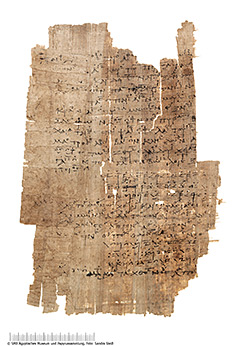P. 6870 V + P. 14097 V
What did music sound like in ancient times? What melodies were sung? We know very little about this. Because even in antiquity, songs were mostly passed on orally or only the lyrics were written down, since the melody could be assumed to be known. Despite these poor conditions, remnants of melodies have survived. One such example is this compilation of musical pieces with musical notation (an audio sample can be found at the end of this text).
Written on the back of a Latin military document from 156 AD, it comprises the left half of a column of 23 musical lines that can be assigned to up to five different pieces of music: up to three of them vocal with notation written above the text syllables, the other two clearly indented are purely instrumental.
The first twelve lines contain a Paian set in today’s tenor register and therefore to be sung by men. It is a solemn choral chant in honor of the god Apollo, which was usually accompanied by the kithara, Apollo’s instrument, and occasionally by the aulos. The instrumental piece that follows in the next three lines, while closely related to it musically, is much shorter, so it is probably not an instrumental accompaniment to the Paian, but possibly an epilogue.
The remaining musical lines of this papyrus could also belong closely together, since the second instrumental piece is literally framed by the presumably related four lines of a choral song before it and one line after it. Thus, one might assume that it could have been an instrumental interlude. The chant has several distinct differences from the Paian, the most striking of which is that its setting is in the present soprano range. Thus, unlike the Paian, the piece should be sung by women. This also fits very well with its content, which is to be found in the context of the Trojan War. The suicide of Aiax is treated from the point of view of his lamenting wife Tecmessa. Aiax had thrown himself on his own sword out of shame for the deeds he had done in frenzy.
These notations appear in two types: a vocal notation for singing and a somewhat older instrumental notation. The former is based on the Greek alphabet still in use today: the notes of the octave f’–f are represented with the regular letters. The characters of the notes outside this octave are upside-down Greek letters, a few freely invented characters, or letters with small dashes. The instrumental notation, on the other hand, is composed of the letters of the older Phoenician alphabet. Although small strokes and a few invented characters are also used in this system to notate notes outside a central double octave a’–A, note elevations and the like are not represented by other letters, but by mirroring or rearranging the corresponding regular letters. Thus, almost every character can be assigned to a note in our present notation system. For notation of the rhythm, dots and the like are occasionally used to indicate lengths and shortenings. For vocal notation, however, basically the meter of the respective text applied.
If we now take a look at the individual pieces of music that have been preserved on this papyrus, a very disparate picture emerges. The Paian and the Aias-fragment have no similarities in content. They also diverge musically, while the instrumental pieces are closely related to the Paian. Thus, the purpose of this compilation of musical pieces on this papyrus was obviously not in the text and its content, but rather in the music. The individual examples may have come from a musical manual and were compiled here for a reason that is not clear. Since they were written on the back of a document that was no longer in use, one could think, for example, of notes for practice purposes. A compilation of individual examples for a theoretical consideration of music cannot be ruled out as a purpose either.
Computer generated audio samples of all melodies on this papyrus can be found on Stefan Hagel’s website „Ancient Greek Music“ under the rubric „The Melodies“ (look for PBerlin 6870 in the table further down that website).
This highlight of the Berlin papyrus collection with reference to ancient music was on display in the special exhibition „Soundscapes – Music in Ancient Egypt“.



